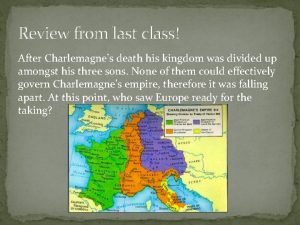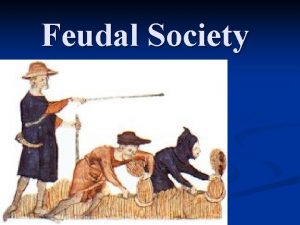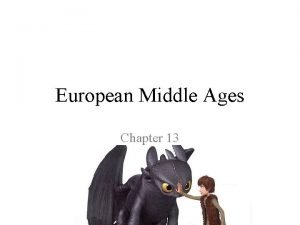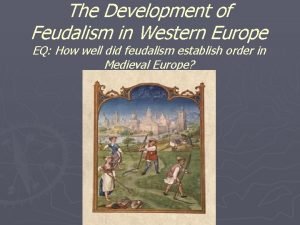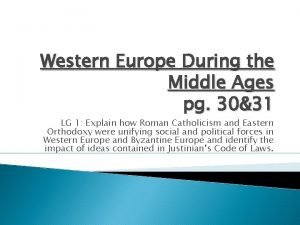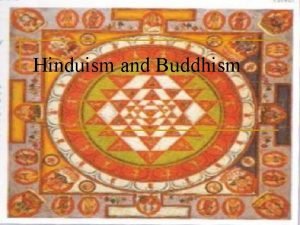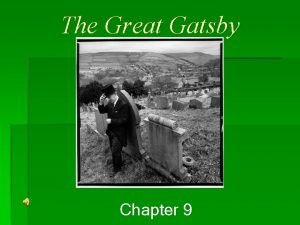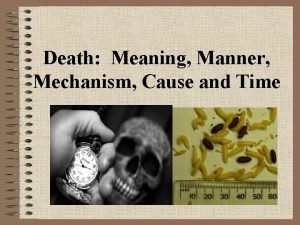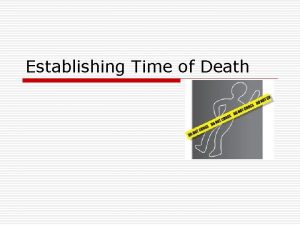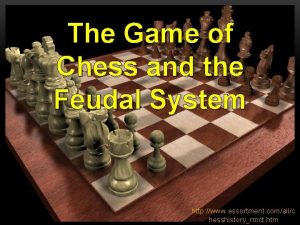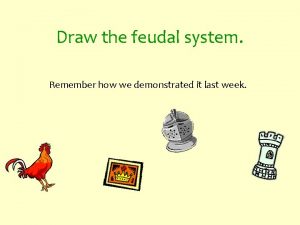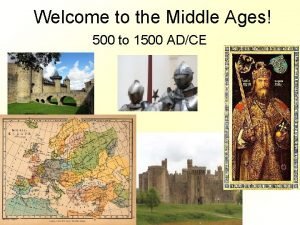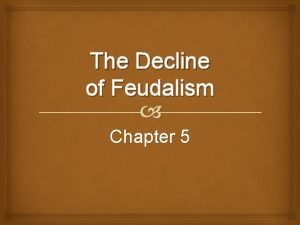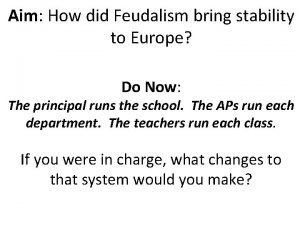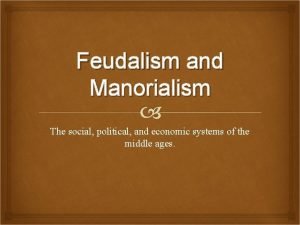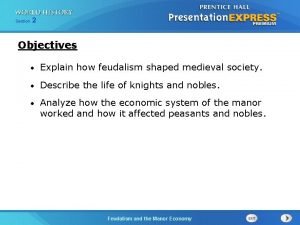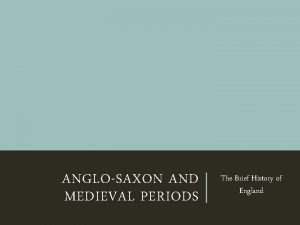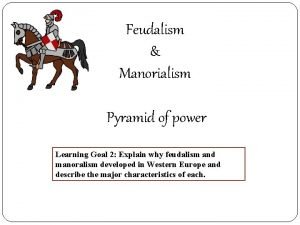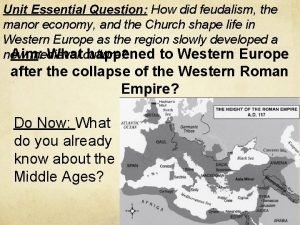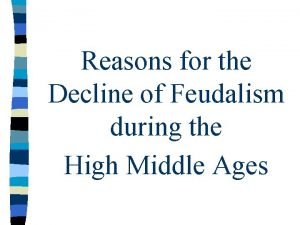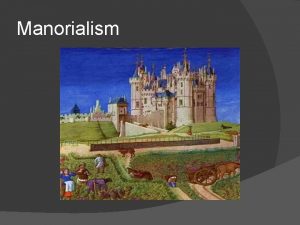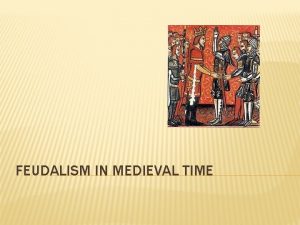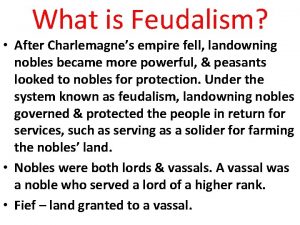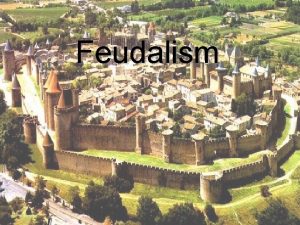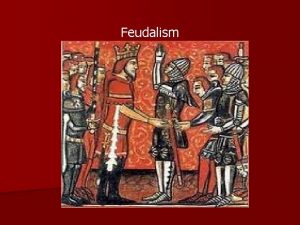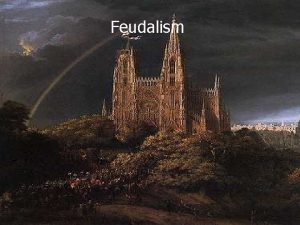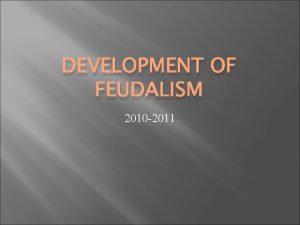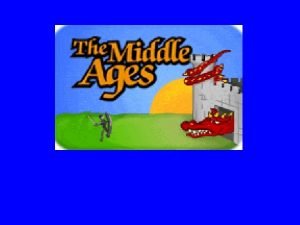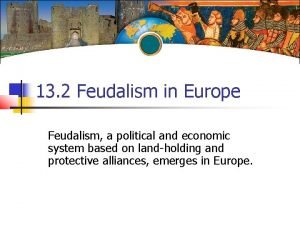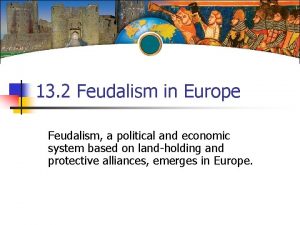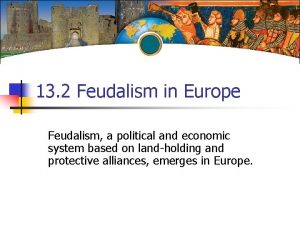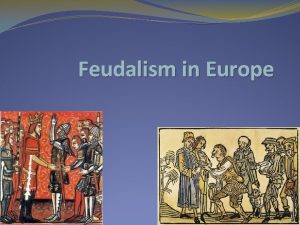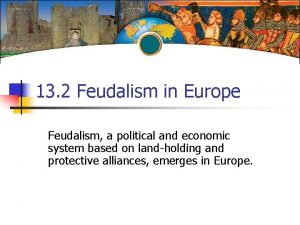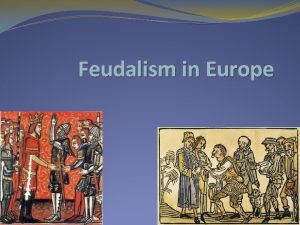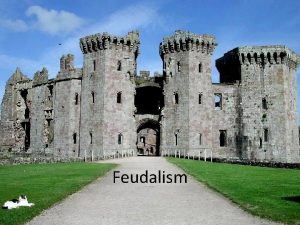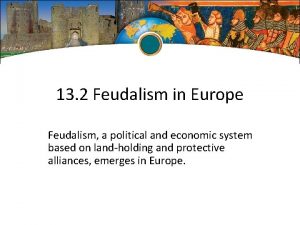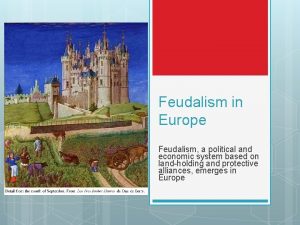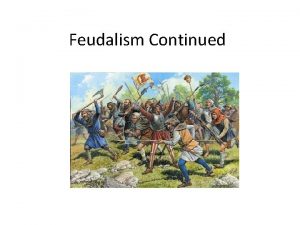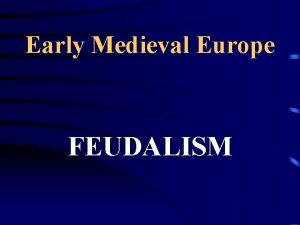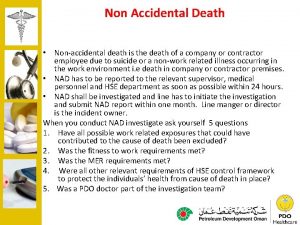FEUDALISM FEUDALISM IN EUROPE After Charlemagnes death largescale

















































- Slides: 49

FEUDALISM

FEUDALISM IN EUROPE • After Charlemagne’s death, large-scale central government all but disappeared again. • Feudalism developed. It had begun before Charlemagne in some places, and after Charlemagne it was the only form of political organization in most of Europe.

WHAT IS FEUDALISM • Feudalism was a system of government based on the relationship between Lords and Vassals, in which a lord granted land (called a fief) to a Vassal in exchange for military service.

LORDS & VASSALS • Lord: a noble who gave land (fief) and protection to another noble called a Vassal. A Lord might himself to a Vassal to another Lord. • Vassal-any noble who pledged loyalty and military service (this pledge was called fealty) to a Lord in exchange for land. A Vassal might also be a Lord to someone under him. • Lords and Vassals were loosely arranged in what we call the “feudal pyramid”.

Feudal Pyramid • The “feudal pyramid” was a hierarchy that usually had a King or Queen at the top, Higher Lords (H. L. ) under him, Lower Lords (L. L. ) under them, Common Knights (C. K. ) under them, and peasants or serfs (S) at the bottom:


King/Queen • King/Queen: – In theory he owned all the land of the realm, although really his power was quite limited. – He could not control all his land himself, so he kept a piece of it, called his “domain”, and divided the rest among his vassals.

HIGHER LORDS • Higher Lords: – The Higher Lords were the Vassals of the King. They promised him loyalty & military service in exchange for control of a large piece of land. – Higher Lords kept a piece of land for themselves, and divided among Lower Lords, who were their Vassals. – The pledge was called fealty: the H. L. knelt before the King placed his hands in the King’s hands, and pledged loyalty & military service. The fief was the land granted to the vassal. – High Lords might have different titles in different countries: Duke, Count, etc. . They could also be Bishops or other Church officials.

Lower Lords • Lower Lords: – Vassals of a Higher Lord. – The Lower Lord received land from the Higher Lord, and promised him loyalty & military service. The pledge of loyalty & military service was called fealty (same type of ceremony) – The Lower Lord kept a piece of land for himself (his domain) and divided the rest among Common Knights, who were his vassals

Common Knights • Common Knights : – Common Knights were the Vassals of the Lower Lords. – Received a piece of land in exchange for a pledge of loyalty & military service (fealty—same type of ceremony) – Most men of the nobility were, including Kings, Higher & Lower Lords, were technically. knights (mounted warriors). Common Knight just means that he had no higher title, he was just “Sir _______”. They were the lowest of the noble class. – A Common Knight was the Lord of a Manor, with peasants and serfs under him. He was their Lord.

3 KINDS OF PEOPLE • THOSE WHO FIGHT – the noble class. Their role in society was to protect the others. The men were knights, trained for war. • THOSE WHO PRAY – the clergy: priests, monks & nuns. Their role was to pray for and care for the souls of themselves & all the other. • THOSE WHO WORK: - the peasants & serfs. Their role was to provide the food for themselves & all the others.

FEUDAL PYRAMID • In theory, the feudal system was a perfect pyramid. In realty, it was more complicated. – There might be no level between High Lords & Common Knights, or there might be several. – Also, a Vassal could hold more than one piece of land, and thus simultaneously be a Vassal of more than one Lord. The Lord to which he first swore fealty was his “liege lord”, and he owed 1 st loyalty to him. Even Kings could be Vassals of another King, if they held land in another country. – There wasn’t necessarily a King at the top. There might be no king, and a Higher Lord was at the top of his own pyramid.

FEUDAL SYSTEM • The relationship between Lord & Vassal was a sacred contract. Vassals weren’t suppose to break their oaths of loyalty, but sometimes things happened. . . – It seems that the King was very powerful, but his power depended on the loyalty of those below him. In order to fight, his Vassals had to bring warriors. – The Lords had almost total control in their own lands. The King rarely interfered with the decision of a Vassal about how to run his land. • When a Vassal died, the land usually passed to his oldest son, and this son pledged “fealty” to father’s Lord. The passing of the whole estate to the oldest son was called “primogeniture”. In the earliest part of the Middle Ages, sometimes all sons shared. This was found to weaken the estate. By 1100 AD, primogeniture was the custom.

FEUDAL SYSTEM-inheritance • When a Lord/Vassal died, the land usually passed to his oldest son, and this son pledged “fealty” to father’s Lord. • The passing of the whole estate to the oldest son was called “primogeniture”. – In the earliest part of the Middle Ages, sometimes all sons shared. This was found to weaken the estate. By 1100 AD, primogeniture was the custom. – Younger sons often became priests or looked for rich girls to marry. • If a noble only had a daughter, the land passed to her as her dowry. It was hers in one sense, but whoever she married had control of it.

FEUDAL SYSTEM • The feudal system was a decentralized government. • No one planned feudalism. It evolved because people needed protection and security, and there was no strong central government that could actually exert control over all the land. • There was a lot of violence, and weaker people put themselves under the protection of a stronger person.

KNIGHTS—”those who fight” • Knight-a mounted warrior. • “Chevalier”-French term for a knight; means a horseman • Most male members of the nobility were Knights. Common Knights were those with no other title. • Trained from their youth to fight.

KNIGHTS-equipment • Horse-usually a strong war horse, bigger than regular riding horses, because it had to carry the knight in his armor. Always a stallion. • Armor: Chain Mail, made of small links of iron. Later Knights wore scale armor, made of solid pieces. • Weapons: Iron helmet, lance & sword. The Sword was the most important weapon.

Knights-stages in training • Page– At about 7 years old, a noble boy went to live in the home of a friend of his father, and became a page. – Learned to take care of armor, weapons & horses; Learned the skills of riding and practiced fighting with a wooden sword. – Served the Lord’s family at the dinner table and learned manners

Knight-stages in training • Squire – At about 14, a boys became a Squire, and assistant to a Knight, and served as a Squire until he was at least about 20. – The Squire took care of his Knight’s horse & weapons, and went with him into battle, but didn’t fight.

Knights-stages in training • Knight: – He became a knight at about 20. – There was a ceremony in which he prayed in a church all night. – He took an oath of knighthood—Code of Chivalry —to defend the Church, women, and the weak; never to fight unfairly or take advantage of anyone (some lived up to it some of the time. . ) – He was “dubbed” – tapped or whacked on the back with a sword by another knight.

TOURNAMENTS & JOUSTS • These were ways to keep the skills of war during peacetime. They became a sport. • Joust-a fight between two knights, usually with blunt spears on horseback. • Melee-a fight among a lot of knights. • Tournament-a large gathering at which there were many jousts and maybe a melee.

WAR • In the early Middle Ages, there were many small, regional wars between Lords in a region. • Later, there were larger wars between whole countries. • The NOBLES seemed to glorify war. They were trained for it as KNIGHTS, and it was one of their major occupations. • In the early Middle Ages, the KNIGHTS fought with small armies of foot soldiers. The PEASANTS usually did not fight, but the suffered terribly, because often their fields were ravaged by the opposing armies and starvation could result.

WARS & the Church • The Church (R. C. C. ) passed 2 rules, to try to restrain the bad effects of war. – Peace of God-rule that said that non-combatants (women, peasants, clergy) and food resources (fields) should not be harmed in war. – Truce of God-rule limited the days of the week on which fighting between Christians could take place. Originally it said no fighting on Sundays; it was later extended to no fighting Thursday-Sunday, or during Lent, or on Holy Days.

JUSTICE IN THE EARLY MIDDLE AGES • A lot different from Justice during the Roman Empire!!! • Based on superstition. 3 main ways: – Trial by Battle: a duel between accuser & accused. The belief was that God would give victory to the innocent party. If the person couldn’t fight, she/chose a champion. – Trial by Compurgation-oath taking. The accuser & accused each got as many people as possible to take an oath supporting him. The side with the most oath-takers won. – Trial by Ordeal-(strangest)-The outcome was determined by some kind of strange test. The accused, or both parties, had to do something like carry a piece of hot iron, or plunge his hand into boiling water, or survive immersion in water. If the person’s sounds healed quickly, he was innocent. If not, he was guilty.

Serf in the Middle Ages (23 min)

Noble in the Middle Ages(23 min)

Feudalism HTW

The Greatest Knight

Greatest Knight

Knight in the Middle Ages (23 min)

Middle Ages-3 ½ minutes-drawings

Wattle & Daub-(Worst Jobs)




Motte and Baily













 Charlemagnes death
Charlemagnes death Charlemagnes death
Charlemagnes death Charlemagnes kingdom
Charlemagnes kingdom John 14
John 14 After me after me after me
After me after me after me Chapter 13 section 2 feudalism in europe
Chapter 13 section 2 feudalism in europe Chapter 13 section 2 feudalism in europe
Chapter 13 section 2 feudalism in europe Feudal europe power pyramid
Feudal europe power pyramid The development of feudalism in western europe
The development of feudalism in western europe Somatic and molecular death
Somatic and molecular death Europe after world war 2 map
Europe after world war 2 map Who was the leader of the franks
Who was the leader of the franks Questioning faith after death
Questioning faith after death Things fall apart locusts
Things fall apart locusts After death images
After death images Why does rigor mortis occur
Why does rigor mortis occur Corpse wax
Corpse wax Featal distress
Featal distress What do muslims believe about life after death
What do muslims believe about life after death Dharmannn
Dharmannn Hopalong cassidy the great gatsby
Hopalong cassidy the great gatsby Rabbit hair medulla
Rabbit hair medulla Meaning:manner
Meaning:manner Hair growth after death
Hair growth after death Diaphanous test
Diaphanous test Stages after death
Stages after death Feudal system game
Feudal system game Centralized feudalism
Centralized feudalism How to draw feudalism
How to draw feudalism Socialism capitalism hybrid
Socialism capitalism hybrid Feudal pyramid of power
Feudal pyramid of power How did feudalism organize society
How did feudalism organize society Feudalism and manorialism venn diagram
Feudalism and manorialism venn diagram The decline of feudalism chapter 5 answer key
The decline of feudalism chapter 5 answer key Feudalism
Feudalism Manorialism drawing
Manorialism drawing Feudalism social pyramid
Feudalism social pyramid Events in primitive era related to physical education
Events in primitive era related to physical education Feudalism def
Feudalism def How did feudalism shape medieval society
How did feudalism shape medieval society Industrial revolution cartoon
Industrial revolution cartoon Anglo saxon feudal system
Anglo saxon feudal system Manorialisms
Manorialisms A salaried worker in the guild system
A salaried worker in the guild system Feudalism manor
Feudalism manor Reason for the decline of feudalism
Reason for the decline of feudalism Feudalism capitalism socialism
Feudalism capitalism socialism Japanese feudal hierarchy
Japanese feudal hierarchy How is manorialism connected to feudalism?
How is manorialism connected to feudalism? Feudalism 2 guide
Feudalism 2 guide
